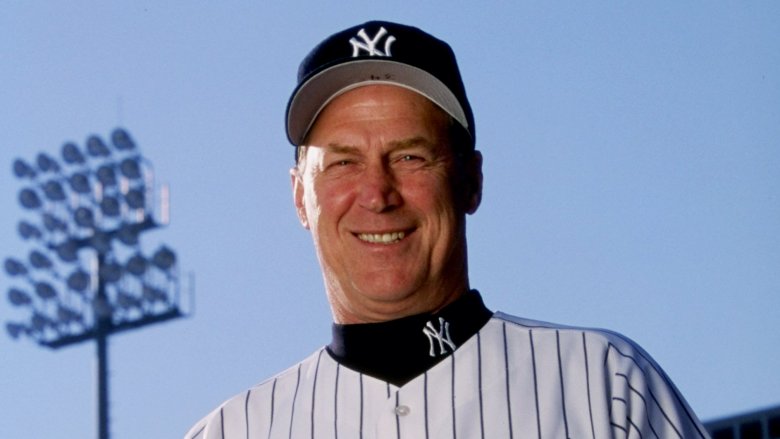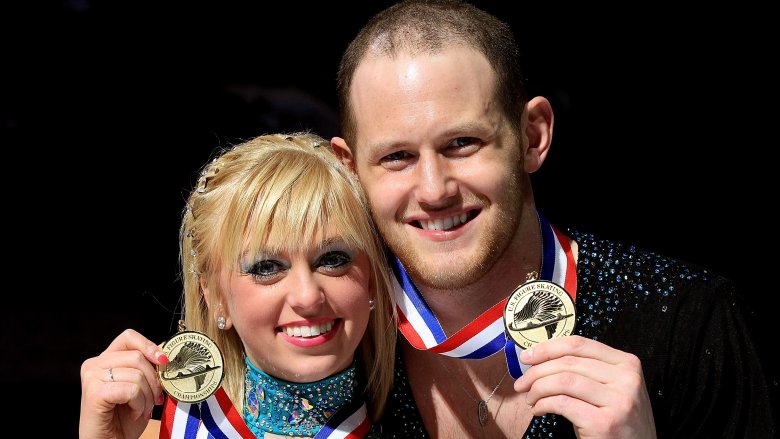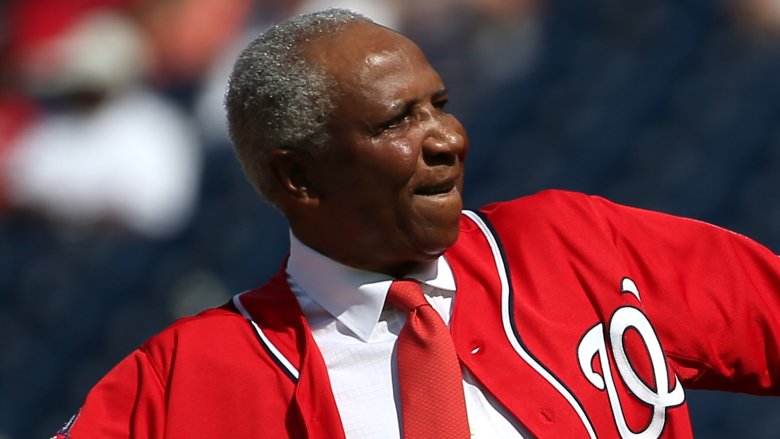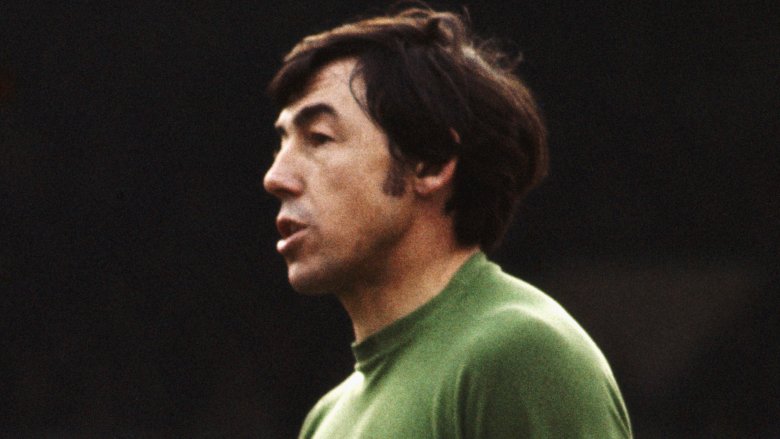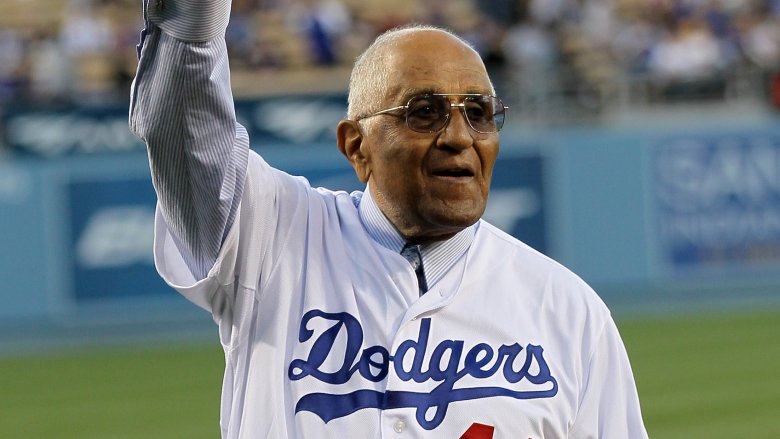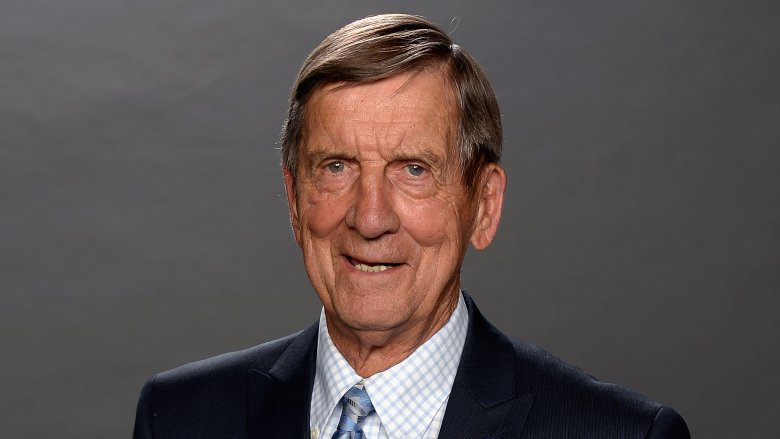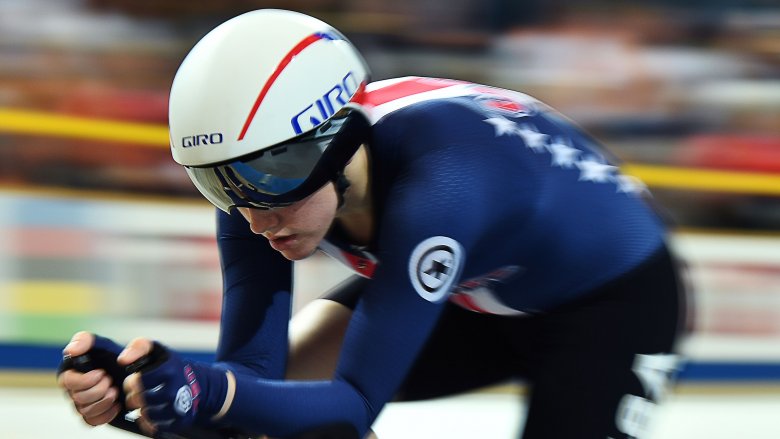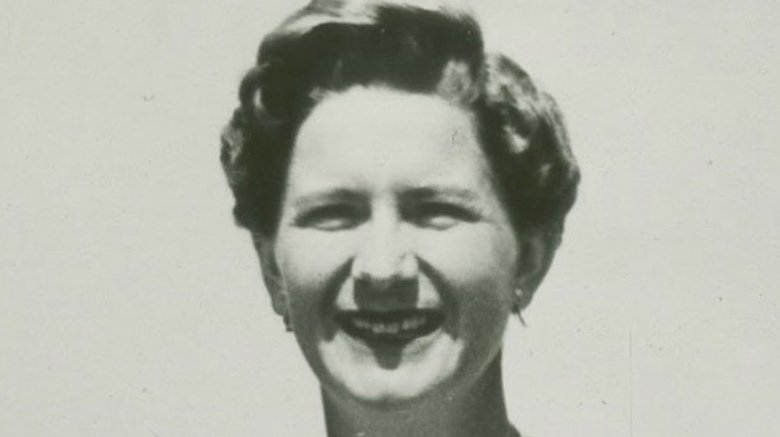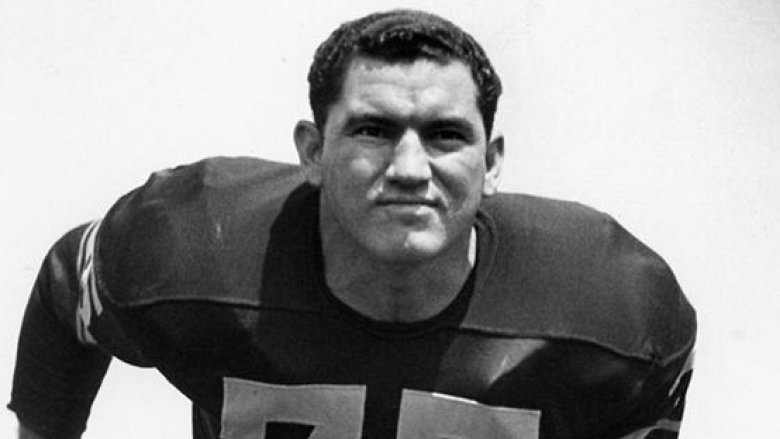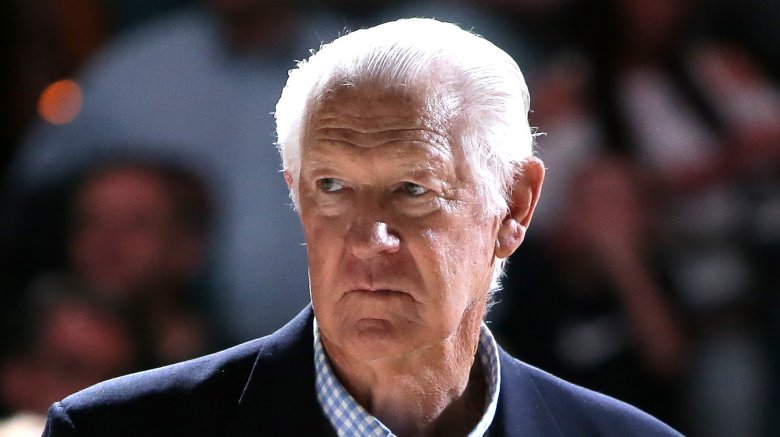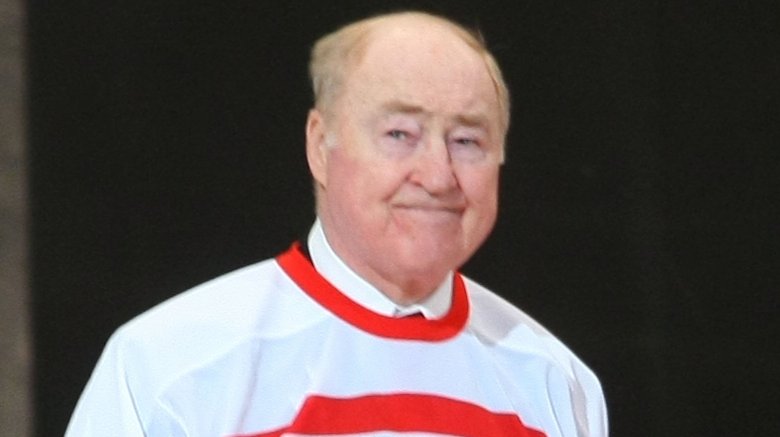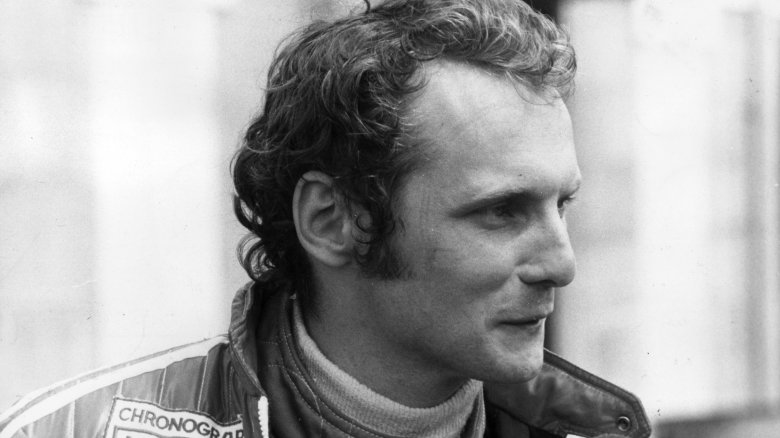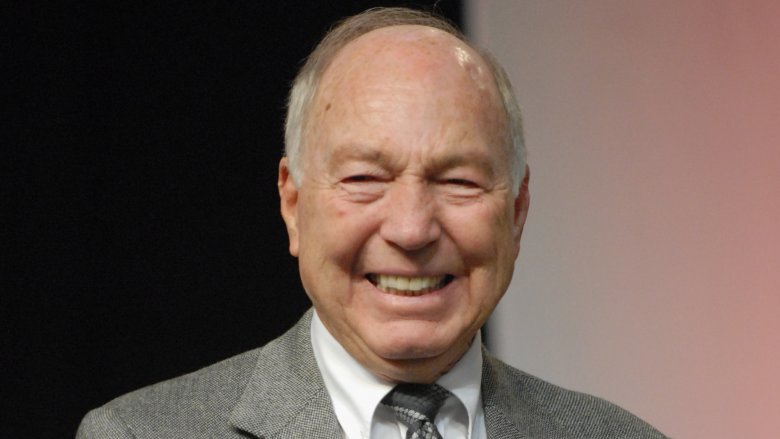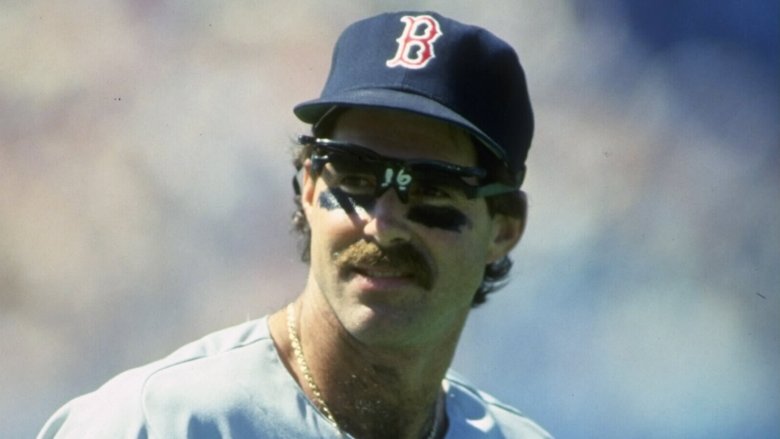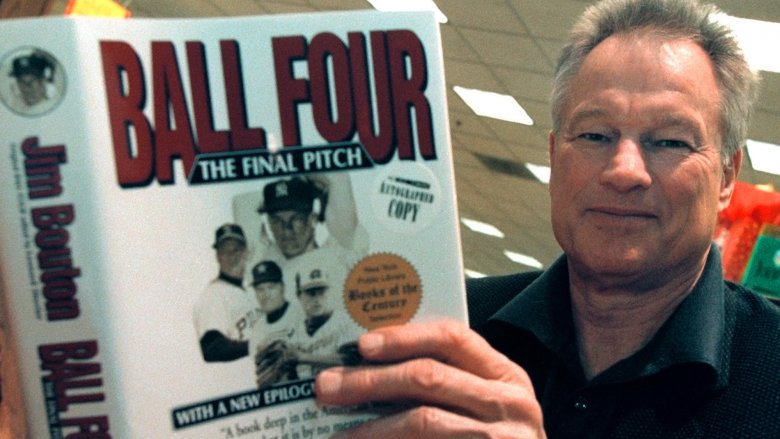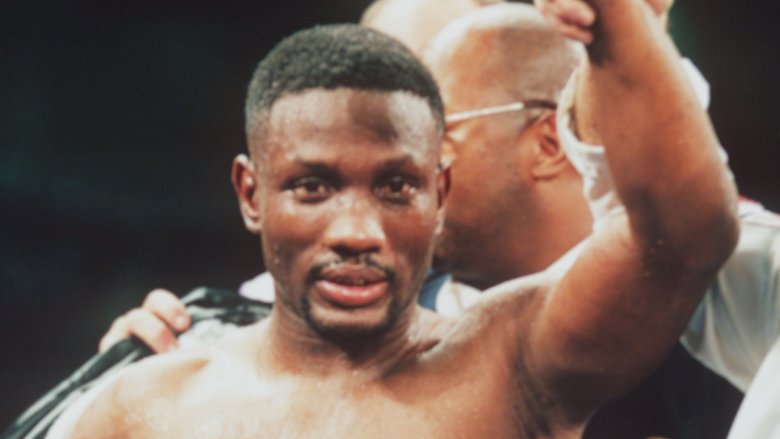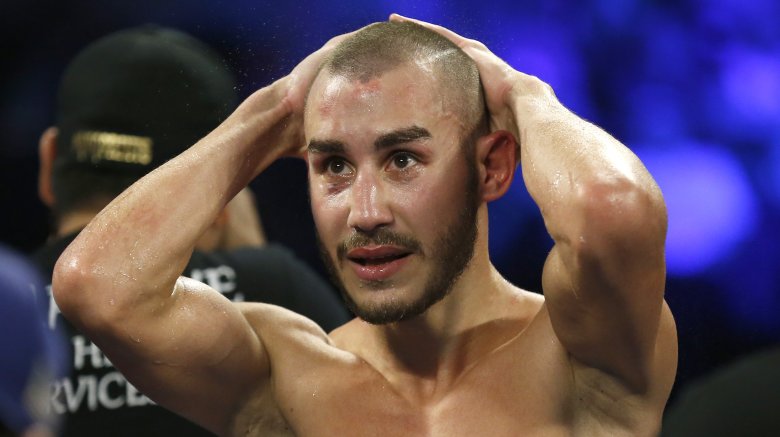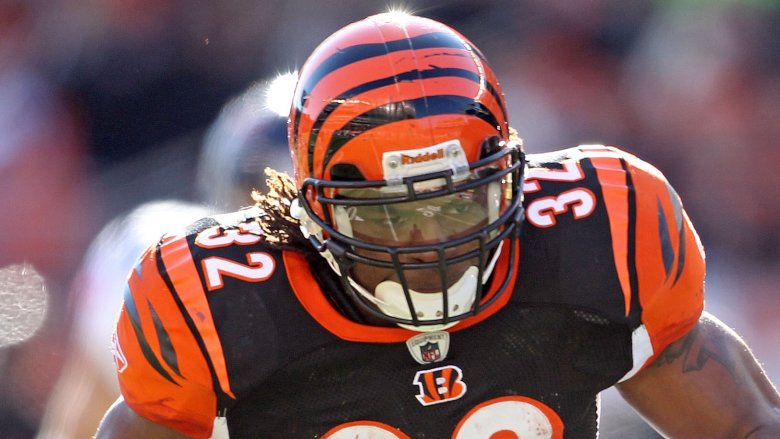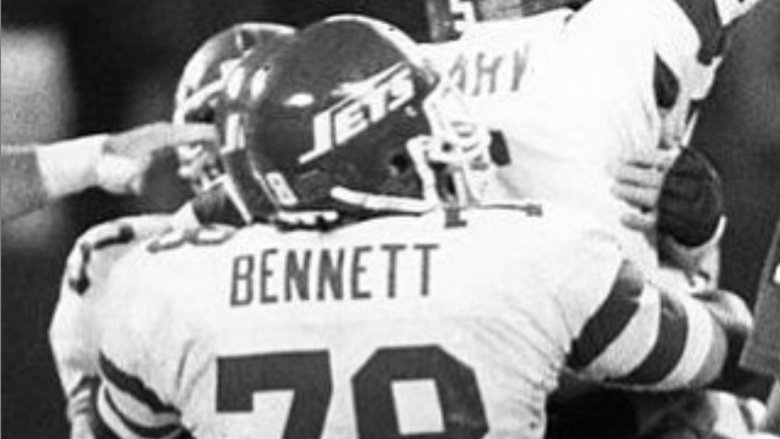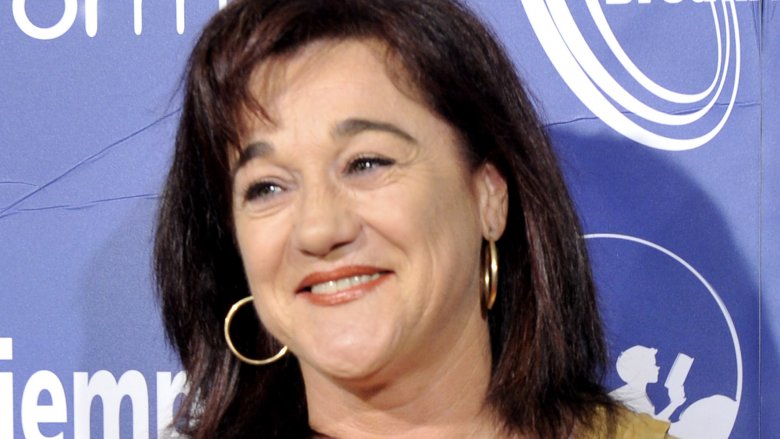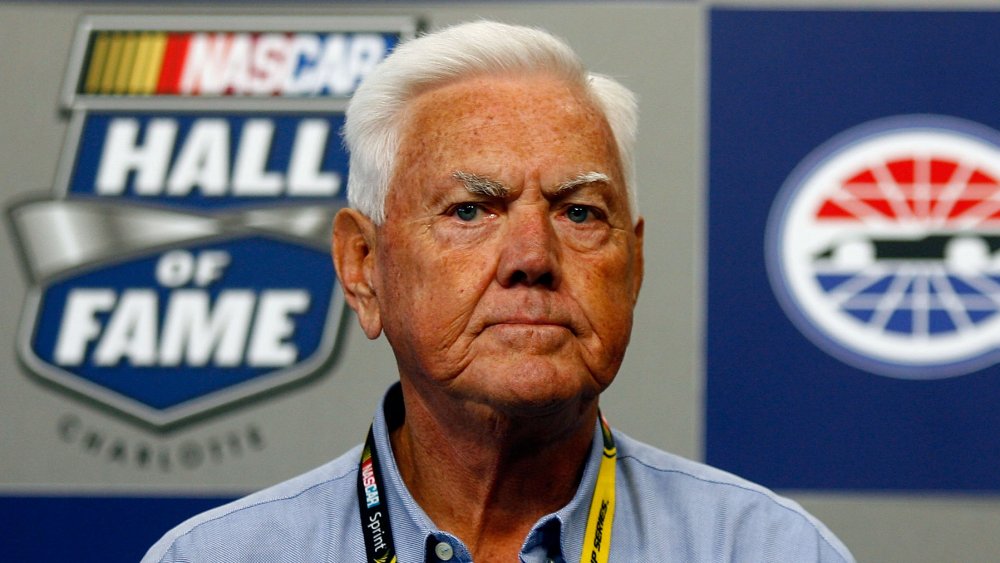Athletes We Lost In 2019 So Far
Most of us look up to athletes because they amaze us. They can run faster, jump higher, and exhibit feats of strength that are so next-level they seem like the acts of a superhero. Is there anyone who hasn't imagined what it would be like to take (and make) the winning shot of Game 7 of the NBA Finals, or hit a World Series-winning grand slam? Well, a very small percentage of the population has the wherewithal, skill, and ability to actually go out and do that kind of thing for a living.
World-class and professional athletes seem so exceptional and otherworldly at times on the court, field, rink, or diamond that they seem immune to the frailties of the human body. But alas, they are human beings — human beings who are really good at ball-handling or puck-handling or body-handling — and human beings die. Here are some all-time legends of sport who died in 2019.
Mel Stottlemyre was a New York legend
While he pitched for the New York Yankees from 1964-1974, during one of the storied franchise's longest periods without a World Series championship, Mel Stottlemyre was a reliable and vital member of the pitching staff. He amassed some very respectable career numbers: 164 wins against 139 losses, a 2.97 earned run average, more than 1,200 strikeouts, three 20-win seasons, and five all-star appearances. Most of his career came before the introduction of the designated hitter in the American League, and Stottlemyre was one of the better hitting pitchers. He once had five hits in one game, and of his seven career home runs, one was an improbable inside-the-park grand slam.
Stottlemyre didn't win a ring as a player, but he did win five as a pitching coach. In the '80s, he signed on with the New York Mets and helped its legendary 1986 squad to a World Series championship. After a stint in Houston, Stottlemyre returned to the Yankees, and as a pitching coach there won another four titles. He retired in 2008 after one last coaching job with the Seattle Mariners, and according to his wife, fought blood cancer for nearly two decades. He died on January 13 at age 77.
John Coughlin skated to early success
Over the past 15 years, American figure skater John Coughlin rose through the ranks of pairs skating and captured a number of titles and high finishes. With partner Lucy Galleher, he placed sixth in the junior division at the 2004 U.S. Championships, and with Bridget Namiotka, finished in second place as a junior at the 2006 U.S. Championships. When he moved up to the adult division, Coughlin was even more successful, winning pairs titles in 2011 with partner Caitlin Yankowskas and in 2012 with Caydee Denney.
Coughlin kept skating in pairs events while also entertaining sidelines as a figure skating coach and TV commentator. His career came to a crashing halt in December 2018, however, when the U.S. Center for SafeSport restricted his eligibility, suspending the skater from competition. That organization, founded in 2017, has jurisdiction regarding sexual misconduct violations and rooting out other forms of abuse in Coughlin's sport, with U.S. Figure Skating compelled to enact its punishments. Coughlin faced three sexual misconduct reports, according to an anonymous source who spoke to USA Today.Coughlin took his own life at his father's home in Kansas City on January 18. The figure skater was 33.
If you or anyone you know is having suicidal thoughts, please call the National Suicide Prevention Lifeline at 1-800-273-TALK (8255).
Frank Robinson broke records and barriers
Frank Robinson achieved nearly everything a player can achieve in Major League Baseball. Debuting in 1956 — for which he was named the National League Rookie of the Year — Robinson spent 10 seasons with the Cincinnati Reds. In 1961, he led the team to its first pennant in more than 20 years thanks to a .323 batting average and 37 home runs. The Reds didn't win the World Series, but Robinson did earn the NL's MVP honors as well as a Gold Glove.
The Reds traded Robinson to Baltimore ahead of the 1966 season, and he immediately delivered for the Orioles, hitting .316 with 49 home runs and 122 runs batted in. He led the league in all three categories, earning Robinson the exceedingly rare "Triple Crown" of hitting. (Only two players have done it since.) Oh, and the Orioles won the World Series, too.
After bouncing around the league, Robinson wound up in Cleveland, where in 1975 he was appointed player-manager, making him the first African-American boss in baseball history. He retired from play to focus on managing in 1976, and in 1989, during a stint with the Baltimore Orioles, he was named Manager of the Year. Tenth on the all-time home run list (with 586), Robinson was a first-ballot Hall of Famer in 1982. The baseball all-timer was 83.
Gordon Banks met his goals by blocking others'
Gordon Banks had a long and successful career in English league soccer (sorry, football) as a goaltender for Leicester City and Stoke City, so good that he won a spot on England's national team in 1963. He rose to the occasion of playing on the world stage and will forever be a legend in his home country as part of the 1966 World Cup-winning squad. England defended its title in the 1970 World Cup final, this time facing the Brazilian team, lead by Pele, widely regarded as the greatest soccer player of all time. While Brazil ultimately squeaked out a 1-0 win, the game is more memorable for a Banks deflection now known as the "save of the century." Pele hit a textbook header toward the lower corner of the net, but Banks somehow knocked it away.
The International Federation of Football History and Statistics ranked Banks the #2 all-time goalkeeper in international play. Banks died in his sleep at age 81.
Don Newcombe brought a title to Brooklyn
Don Newcombe was one of the last living players who remembered taking the field in Brooklyn during Major League Baseball's much-celebrated mid-20th century. Newcombe played for the Cincinnati Reds and Cleveland Indians, but he'll forever be associated with that distinctive Dodger blue.
While playing semi-pro baseball as a teenager — because his New Jersey high school didn't have a team — Newcombe got the attention of Brooklyn Dodgers executive Branch Rickey, who signed him to the team. Newcombe was among the first African-Americans to play in the MLB, entering the league in 1949, just two years after teammate Jackie Robinson broke the color barrier. After a Rookie of the Year-winning debut season in which he amassed a 17-8 record with five shutouts and 149 strikeouts, Newcombe got even better winning 19 and 20 games in the next two seasons. He then missed two seasons to serve in the military during the Korean War. But he came back in a big way — in 1955 he won 20 games and led the Brooklyn Dodgers to a World Series title. And the following year, he won an astounding 27 times and was named both the National League's MVP and its Cy Young Award recipient. (Along with Justin Verlander, Newcombe is the only player in MLB history to win Rookie of the Year, MVP, and Cy Young honors.)
According to the Dodgers, Newcombe died on February 19 at age 92.
Terrible Ted wasn't so terrible
Ted Lindsay was a standout in the wild, hardscrabble National Hockey League of the mid-20th century "Original Six" era. Lindsay played more than 1,000 games and scored 379 goals over his 17-season career, and almost all of them were with the Detroit Red Wings. As part of the legendary "Production Line" alongside center Sid Abel and right winger Gordie Howe, Lindsay ultimately won four Stanley Cups in the 1950s. Relatively small at just 5'8", Lindsay was so scrappy and tenacious that he earned the nickname "Terrible Ted."
In 1950, Lindsay won the Art Ross Trophy, the NHL's award for its top scorer. That's just one of a slew of honors Terrible Ted received. He was elected to the Hockey Hall of Fame in 1966, and his 7 hangs in the rafters above Red Wings games. Lindsay earned a spot on the NHL's list of its 100 greatest players of all time, and in 2010, the NHL Players Association (a group he helped form) renamed the league MVP prize the Ted Lindsay Award.
According to his family, Ted Lindsay passed away at his home in Michigan on March 4, 2019. He was 93.
King Kong Bundy was the king of the ring
Every wrestler has to have a hook, and the hook was as important as ability in the colorful WWF/WWE of the late '80s and '90s. Competing against outsized personalities like Hulk Hogan and the Undertaker came Christopher Pallies, aka King Kong Bundy, whose whole deal was being a mountain of a man who wore an old-fashioned wrestling one-piece. The bald Bundy towered over the competition at 6'4" and more than 450 pounds, but he was as fast as he was imposing; one of his signature moves was a belly-flop ... onto his opponents.
Bundy made a big impression at early WrestleMania events. In 1985, he faced off against Special Delivery Jones and defeated him in about 20 seconds. The following year he went up against Hulk Hogan in a steel-cage championship match but came up short. He returned to wrestling in 1993 after a five-year retirement, and also acted a bit, showing up in Richard Pryor's Moving and on Married... With Children. Out of the ring since 1999, Pallies died at his New Jersey home at age 63.
Kelly Catlin rode her way to Olympic glory
Team pursuit is one of the most exciting Olympic events to watch — two teams of riders race each other on a curved indoor track called a velodrome. Kelly Catlin was among the best track cyclists in the world, always putting on an amazing display for spectators. After a running injury at age 17, Catlin took up cycling, and remarkably, just four years later she was competing in the 2016 Summer Olympics in Rio de Janeiro. Catlin and her team won a silver medal there, along with three straight world championships in 2016, 2017, and 2018.
As of late, she had suffered some personal and athletic setbacks. Catlin broke her arm in an October 2018 crash and endured a bad concussion after slipping while riding on a road in December 2018. After a suicide attempt in January 2019, Catlin accepted her coaches' urging to take some time away from racing, and she pulled out of the 2019 Track Cycling World Championships. On March 7, 2019, Catlin took her own life, according to her family. The cyclist was 23 years old.
If you or anyone you know is having suicidal thoughts, please call the National Suicide Prevention Lifeline at 1-800-273-TALK (8255).
Marilyn Smith created professional women's golf, and then dominated it
Every sport has its legends and its icons rightfully enshrined in a hall of fame. Marilyn Smith is that kind of athlete, a Hall of Fame golfer with 21 tournament wins. But perhaps even more impressive is how she also changed the face of women's sports by helping create the Ladies Professional Golf Association, the organizational body of women's golf and the world's oldest women's sports institution. Even as a child growing up in Kansas in the 1930s and '40s, Smith was clearly destined for sports greatness. She pitched on a boy's team, and after her father promised her a new bike when she could hit nine holes in under 40 strokes, she was riding that bike to a Wichita country club. Before she graduated high school, she'd won three state titles. At the University of Kansas she comprised the entirety of the women's golf squad ... and won the individual national golf title in 1949.
Not long after, she left school to go pro. Male golfers had the PGA to organize tournaments, but female golfers had nothing so Smith and about a dozen other golfers created the LPGA in 1950. Smith won her first pro championship four years later and later served as president of the group. After retirement, ABC Sports hired her to cover men's golf tournaments, making her the first woman to ever do that, too. Smith died on April 9 in Goodyear, Arizona. She was 89.
Forrest Gregg was an all-time NFL star
Those grainy, color-saturated, slowed-down films of old NFL games from the '60s often feature what the narrator might describe as "the frozen tundra of Lambeau Field." That's the field of the Green Bay Packers, home to many gridiron greats, including offensive lineman Forrest Gregg. Playing as both a guard and tackle, Gregg was so committed and put in so much effort that legendary Packers coach Vince Lombardi called him "the best player I ever coached." Gregg was a nine-time Pro Bowl selection over the course of a 15-season career (1956–1971) for the Dallas Cowboys as well as the Packers. Throughout it all — in which he earned the nickname "Iron Man" after competing in a then-record 188 straight games — Gregg suited up for six conference championship teams and played in three Super Bowls, winning it all in 1967, 1978, and 1972. The 1977 Pro Football Hall of Fame inductee went on to coach for 11 seasons, leading the Green Bay Packers, Cleveland Browns, and Cincinnati Bengals, who appeared in the 1982 Super Bowl.
On April 12, Gregg died from to complications of Parkinson's disease. He was 85.
John Havlicek bled Celtics green
There are Boston Celtics legends — the players and coaches responsible for the NBA team's multiple dynastic title runs — and then there's John Havlicek. In his 16-year career (1962-1978) with the Celtics, Havlicek won an astounding eight championships, including four in his first four seasons. Only two NBA players won more rings than Havlicek: his teammates Bill Russell and Sam Jones. Havlicek was pretty good in the regular season, too. He scored a total of 26,395 points, making him the top scorer in Celtics history. Some more of Havlicek's accomplishments: 13 All-Star selections, 11 all-NBA team selections, a retired number, and enshrinement in the Naismith Memorial Basketball Hall of Fame.
As he joined a dazzling squad already at work, Havlicek (nicknamed Hondo, for his resemblance to Hondo star John Wayne) graduated to team leader by the mid-'70s and was named the MVP of the 1974 NBA Finals. Not bad for a guy who could have gone pro in other sports. As a teenager in Ohio, Havlicek went All-State in not just basketball, but baseball and football, too. As a baseball star at Ohio State, he batted above .400, and the Cleveland Browns drafted him. But Havlicek ultimately chose basketball, tallying a 78-6 record with a 1960 NCAA title.
The Celtics star died on April 25 at the age of 79. A cause of death wasn't immediately released, but Havlicek had been suffering from Parkinson's disease.
Red Kelly put the "Red" in "Red Wings"
Leonard "Red" Kelly (he had red hair back in the day) was an old-school hockey legend, a tough but fair defensive powerhouse who came of age in the NHL's storied "Original Six" era of the 1940s, '50s, and '60s. Over a 21-season career (1947-1967), Kelly hoisted the Stanley Cup a remarkable eight times, four with the Detroit Red Wings and four with the Toronto Maple Leafs.
Kelly was known primarily for his ability to keep opponents out of the net, spending 13 years as a Red Wings defenseman. But he was pretty good at offense, too, amassing 281 goals and 542 assists, with his output ticking up a bit after he got traded to Toronto and switched to center. Kelly made the NHL All-Star list eight times, won the Lady Byng trophy for sportsmanship four times, and was inaugural recipient of the Norris Trophy (for the league's top defensive player) in 1954. He was a statesman, too. In 1962 — while still playing in the NHL — Kelly won a seat in Canada's Parliament, representing an area of Toronto.
In February 2019, Kelly saw the Red Wings retire his jersey (#4), making him just the eighth player to receive that honor. The Hall of Fame hockey star died on May 2, 2019, at age 91.
Niki Lauda had the Formula for success
In the U.S., the auto sport of choice is NASCAR. In Europe, it's Formula 1, and that circuit has had few stars bigger than Niki Lauda. The Austrian-born racer used family money to buy his way into big races in 1971 and 1972, and by 1973, he was a top-three finisher. Just two years later, he was a superstar. In the 1975 F1 season, he won five of 14 races and easily secured his first World Championship. The following year, Lauda again won five races but was edged out in the final standings — by one point — by his close friend and professional rival James Hunt. (Their dual domination of F1 was dramatized in the 2013 film Rush — Chris Hemsworth played Hunt, and Daniel Brühl received a Golden Globe nomination for his portrayal of Lauda.)
That second-place finish in '76 is miraculous, considering that Lauda nearly died in an early-season crash at the German Grand Prix. In what was likely a suspension failure, his Ferrari smashed into a wall, and as other cars hit him, the vehicle caught fire and severely burned Lauda's face. He was even given last rites ... except he survived and was racing again less than six weeks later. In 1977, Lauda reclaimed his championship, and won another one in 1984 after coming out of retirement. Lauda, who had received a lung transplant in August 2018, passed away on May 20, according to his family. He was 70.
Bart Starr was the first star of the Super Bowl era
Bart Starr led a dynasty in Green Bay, bridging the gap between the era of separate leagues and the time of Super Bowls. The University of Alabama quarterback kind of snuck his way into the NFL, drafted in the 17th round in 1956. He wasn't even a starting QB for awhile, but when he finally got the job full-time, he exploded, helping the Green Bay Packers to NFL titles in 1961, 1962, and 1965. When the NFL and rival AFL started pitting their champions against one another in a "Super Bowl," Starr's teams won the first two iterations.
Starr played in the NFL for 16 seasons, all of them with the Packers. During that time, he was selected for four Pro Bowls, was named the NFL MVP in 1966, led the league in completion percentage four times, and racked up more than 24,000 passing yards. Perhaps his most famous on-field moment is one of football's most famous moments. In the 1967 NFL title game, nicknamed the "Ice Bowl" due to an unbelievably cold game time temperature that felt like -46 degrees Fahrenheit with wind chill, Starr executed a quarterback sneak to give the Packers a 21-17 win over the Dallas Cowboys.
Starr, inducted into the Pro Football Hall of Fame in 1977, had reportedly been in poor health since suffering a heart attack and two strokes in 2014, and he died on May 26 in Birmingham, Alabama. He was 85.
Bill Buckner's career was a lot more than that one moment
Over the course of a 22-year career, Bill Buckner was among baseball's most reliable players. His lifetime stats were solid: a batting average of .289 and 2,715 hits. Buckner peaked in the early '80s during his time with the Chicago Cubs — he was the 1980 National League batting champion and made the All-Star team in 1981. Soon after, Buckner was traded to the Boston Red Sox, where he'd be part of the 1986 World Series-bound squad. But despite all those achievements, it would be a single moment in that Fall Classic that would define and mar Buckner's career and name forever.
The Red Sox nearly broke a 68-year championship drought, up three games to two over the New York Mets with a lead in Game Six. In the tenth inning with the score tied, the Mets' Mookie Wilson hit a slow, easy-to-field grounder to Buckner. He misjudged it ... and it rolled through his legs into the outfield. A Mets runner scored the game-winning run, forcing a seventh game in which the Mets were victorious. Buckner became a Boston sports pariah, single-handedly taking the blame for the Red Sox' continuing misfortunes. After he retired in 1990, he moved to Idaho and bought a ranch.
According to his family, Buckner died on May 27 after suffering from Lewy body dementia. He was 69.
Jim Bouton made it in baseball, then blew the lid off the whole thing
Jim Bouton was a phenom of a pitcher for the New York Yankees in the early 1960s, one of the team's most storied periods. In 1963, just his second full year in the major leagues, Bouton (with a killer fastball) racked up all-star numbers, winning 21 games with six shutouts. The next year he pitched another 18 wins with four shutouts, and in both 1963 and 1964 the Yankees won the American League pennant. He was never quite the same after a 1965 injury, going 4-15 that season before he was relegated to just occasional pitching duties.
Not counting a brief comeback attempt in 1978, his career finished up after 1970 following stints with the Seattle Pilots and Houston Astros. But Bouton would have a huge second act, blowing up the sweet and wholesome mythology "the old ball game" had masked itself in for decades. In 1970, Bouton turned his recollections of his baseball days into Ball Four, a shocking expose of what baseball players really got up to — the main takeaways being that Mickey Mantle liked to party and tons of players ingested performance-enhancing stimulants on the regular. In addition to working as a sportscaster in the New York area, Bouton further added to the magic of baseball by co-inventing Big League Chew. The baseball lifer was 80.
Tyler Skaggs left us far too early
Tyler Skaggs showed signs of pitching greatness well before he was old enough to vote. In his junior year at Santa Monica High School in southern California, Skaggs struck out 89 batters, walked just 22, pitched a perfect game, and notched a ridiculously low 1.11 ERA on the way to being named his conference's player of the year for 2008. The next year, the Los Angeles Angels drafted the local standout, only to trade him to the Arizona Diamondbacks ... who traded Skaggs back to the Angels, where he would spend the rest of his career. Taking the mound more and more each season, Skaggs' best year came in 2018, with a 4.02 ERA and an 8-10 record. In 2019, he'd nearly matched his personal wins record with seven by late June, and shortly after pitching in a home game against Oakland, Skaggs and the rest of the team headed for Dallas for a four-game series against the Texas Rangers. Sadly, he'd never pitch again. After he was found unresponsive in his suburban Dallas hotel room on July 1, 2019, authorities were summoned, who pronounced Skaggs dead. According to an autopsy, he choked to death with large amounts of heavy drugs and alcohol in his system. Skaggs was just a few days away from his 28th birthday.
Greg Johnson was all about leadership
In the hockey-mad northern United States, Greg Johnson was a superstar while still in college. At the University of North Dakota in the late 1980s, the Ontario-born forward scored 272 points in four seasons, making him the school's all-time top scorer. Drafted in 1989, he finally hit the NHL ice in 1993 for the Detroit Red Wings and bounced around the league for a while until 1998, when he became one of the first-ever players for the expansion Nashville Predators. Johnson was named team captain, a position of leadership he deeply enjoyed. According to his former agent, Tom Laidlaw, Johnson invited criticism from the NHL Players Association because he refused to negotiate with the Predators for a bigger contract so as not to alienate management to the point where they stripped him of his "C."
After a physical uncovered an irregular heartbeat, Johnson retired after a 12-year pro career at the relatively young age of 35. Johnson died on July 7, 2019, in his Detroit-area home at the age of 48.
Pernell Whitaker's moves were so sweet they called him Sweet Pea
Pernell Whitaker made quite the debut on the boxing scene back in 1984. As part of Team USA, the slight (5'6") southpaw out of Norfolk, Virginia, took home a gold medal at the 1984 Summer Olympics. Just a few months later, he made his professional debut in the ring, showing off not only jabs and blows but some of the craftiest defense in boxing history. Nicknamed "Sweet Pea," Whitaker amassed a remarkable record of 40 wins, four losses, and one draw over the course of a 17-year career. Of those victories, 17 were knockouts and 21 were unanimous decisions — he was just that dominant in his weight classes, of which he had several. Whitaker won titles in an unheard of four separate weight classes: lightweight, junior welterweight, welterweight, and junior middleweight. Whitaker was named to the International Boxing Hall of Fame in 2006.
Police in Virginia Beach, Virginia, say that on the evening of July 14, he was struck by a car while walking through an intersection. Sweet Pea Whitaker was 55.
Boxer Maxim Dadashev died as the result of a bout
Since joining the professional boxing circuit in 2016, Russian-born but California-based fighter Maxim Dadashev proved himself a formidable competitor in the junior welterweight class. He won his first 13 fights, and an impressive 11 of those came via undisputed knockouts. His first professional loss, however, would prove tragic.
On July 19, 2019, Dadashev squared off in Oxon Hill, Maryland, against Puerto Rican boxer Subriel Matias, who also came into the match with a perfect 13-0 record. The stakes were high, as the winner advanced to a championship fight against Josh Taylor. Matias dominated the fight from the beginning, landing numerous hard blows to Dadashev's head. He so overwhelmed and brutalized his opponent that Dadashev's trainer, Buddy McGirt, considered ending the fight after the ninth round. But Dadashev kept fighting, up through the 11th round, when McGirt finally put a stop to the bout. That gave Matias, ahead on the scorecards, the win via TKO.
But that stoppage would prove too late — Dadshev collapsed and vomited on the way to his dressing room. Paramedics rushed the fighter to a local hospital for emergency surgery to treat bleeding on the brain. Doctors placed him in a medically induced coma, but Dadashev would ultimately succumb to his injuries on July 23. He was 28 years old.
Cedric Benson
From 2001 to 2004, Texas Longhorns running back Cedric Benson put up some of the most impressive stats in college football history. He rushed for well over 1,000 yards in each of his four seasons, and his 5,540 total yards put him at ninth on the all-time list. His 64 touchdowns are the second-best ever at Texas. In his senior year, Benson exploded with 1,834 yards and 19 touchdowns, winning him the Doak Walker Award (recognizing the nation's top running back); he finished sixth in Heisman Trophy voting. The Chicago Bears selected Benson with the fourth overall pick in the 2005 NFL Draft and in 2007 he helped lead the team to its first Super Bowl appearance in more than two decades. The running back played a total of eight seasons in the pros — for the Bears, Cincinnati Bengals, and Green Bay Packers — rushing for more than 1,000 yards three times, with career totals of 6,107 rushing yards and 32 touchdowns.
On the evening of August 17, 2019, Benson took his motorcycle out for a spin in Austin, Texas. Police say a minivan was attempting to cross through an intersection and struck that motorcycle. Benson and a female passenger were pronounced dead at the scene. Benson was 36 years old.
Barry Bennett
Drafted out of Concordia College in the third round by the New Orleans Saints in 1978, Barry Bennett played for 11 seasons in the NFL. A defensive tackle and defensive end, he was a reliable member of the line, a starter more often than not and putting up a moderate number of sacks through his four years with the Saints and six seasons with the New York Jets. After playing in one regular-season game for the Minnesota Vikings in 1988, Bennett, a native of the Land of 10,000 Lakes, settled in the small town of Long Prairie, Minnesota, where he worked for years as a physical education teacher and coach. Bennett had retired and remained in Long Prairie with his wife, Carol, and together they were tragically discovered dead from gunshot wounds in their home on August 21, 2019. Within a few days police had arrested a suspect – Bennett's son, Dylan John Bennett — and charged him with the double murder.
Jessi Combs was the fastest woman on the planet
Since at least as far back as 2012, Jessi Combs was intent on setting a land speed record, not an easy feat and a pursuit that's fascinated motorsport athletes since the dawn of the automobile age. But in 2013, she actually did it, becoming "the fastest woman on four wheels" when she took a jet-powered car all the way up to 398 mph. Jessi Combs was all about awesome vehicles — in addition to being an avid off-roader, she earned a degree from WyoTech in custom automotive fabrication, she applied that knowledge as a host or on-air personality on several reality shows, including XTreme 4x4, Overhaulin', Truck U, Two Guys Garage, and, most famously, MythBusters.
In 2016, Combs hit 483 mph on a 13-mile course in Oregon's Alvord Desert but had to quit early due to mechanical problems with her jet-boosted car. On August 27, 2019, she attempted it again, this time trying to get her vehicle up to at least 512 mph. Tragically, Combs crashed, and the accident killed her. She was 39.
Blanca Fernandez Ochoa raced into Olympic history
For Blanca Fernandez Ochoa, skiing was an "obsession," and it's a sport she explored and excelled at until she was world-class level in her native Spain, which isn't a country that's produced too many champion skiers. In 1972, slalom skier Francisco Fernandez Ochoa — Blanca's brother — became the first man from Spain to win a gold medal at the Winter Olympics. Twenty years later, Blanca became the first Spanish woman to medal at the Winter Olympics when she took home a bronze medal in the slalom at the 1992 games in Albertville, France. In all, five Ochoa siblings skied for Spain in the Olympics, and Blanca alone competed in four consecutive games in the '80s and '90s.
Ochoa was last seen on August 23, 2019, in Madrid, and about a week later, her Mercedes was located. A large search operation discovered Ochoa's body on September 4, 2019, in a mountainous area. A cause of death is yet to be determined. The skier and hiker was 56.
Mike Stefanik
NASCAR comprises far more auto racing than just its most famous NASCAR Cup Series. The organization comprises several circuits, including truck racing series and the Whelen Modified Tour, which features vehicles that are slightly shorter and wider than the ones in the Cup Series, and with slightly less horsepower. In this style of racing, few were as dominant as Mike Stefanik. Between 1985 and 2014, Stefanik won 74 races on the circuit — a record. In the 1998 season, he won 13 times — another record. Between 1989 and 2006, he won seven circuit championships, along with two in the Busch North, for a total of nine national titles overall, tying him with Richie Evans for the most in NASCAR Modified history. In 2003, he was named the second-best driver ever in his series, and he's been nominated for the NASCAR Hall of Fame six times.
In addition to a driver, Stefanik was also a pilot. On September 15, 2019, he took his tiny, single-engine, single-seat plane out for a flight, departing from Riconn Airport on the Rhode Island-Connecticut border. While making a midair turn, he reportedly lost control of the aircraft and crashed into a grove of trees. NASCAR confirmed that Stefanik, 61, died in the accident.
Junior Johnson took NASCAR mainstream
NASCAR is an outgrowth of people who souped-up their cars to run illegal moonshine through the South. Junior Johnson made his living as one of those "whiskey runners," hauling hooch through the foothills of North Carolina, before he went on to become one of NASCAR's first stars.
Johnson grew up a few miles from the site of the future North Wilkesboro Speedway, and started racing when tracks were still primarily made of dirt. In 1955, he spent his first full season in NASCAR's top division, winning five races. In 1960, Johnson won his first Daytona 500, and during a preliminary race he discovered — and fully exploited the use of — a now prominent technique called drafting, in which cars can receive a big boost from the air and pressure coming off of the vehicle in front of them. Johnson ultimately won 50 races at NASCAR's highest level, but never took home a championship. (His best season: 1965, in which he won 13 of 36 starts). In the late '60s, he started to drive less and moved into a role as a team owner. Under his tutelage, Cale Yarborough amassed 45 wins and three championships, and Darrell Waltrip collected 43 victories and three titles.
The NASCAR legend was among the sport's first Hall of Fame class in 2010, alongside Richard Petty and Dale Earnhardt. After a brief stay in hospice care, Johnson passed away on December 20, 2019, at the age of 88.

